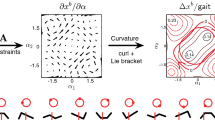Abstract
Snake robots have many degrees of freedom, which makes them both extremely versatile and complex to control. They are often controlled with gaits, coordinated cyclic patterns of joint motion. Using gaits simplifies the design of high-level controllers, but shifts the complexity burden to designing the gaits. In this paper, we address the gait design problem by introducing two algorithms: Annealed chain fitting and Keyframe wave extraction. Annealed chain fitting efficiently maps a continuous backbone curve describing the three-dimensional shape of the robot to a set of joint angles for a snake robot. Keyframe wave extraction takes joint angles fit to a sequence of backbone curves and identifies parameterized periodic functions that produce those sequences. Together, they allow a gait designer to conceive a motion in terms three-dimensional shapes and translate them into easily manipulated wave functions, and so unify two previously disparate gait design approaches. We validate the algorithms by using them to produce rolling and sidewinding gaits for crawling and climbing, with results that match previous empirical investigations.
Similar content being viewed by others
References
Andersson, S. B. (2008). Discretization of a continuous curve. IEEE Transactions on Robotics, 24(2), 456–461.
Burdick, J., Radford, J., & Chirikjian, G. (1993). A “sidewinding" locomotion gait for hyper-redundant robots. In IEEE international conference on robotics and automation (ICRA) (Vol. 3, pp. 101–106).
Chirikjian, G. (1992). Theory and applications of hyper-redundant robotic manipulators. Ph.D. thesis, California Institute of Technology.
Chirikjian, G., & Burdick, J. (1991). Kinematics of hyper-redundant locomotion with applications to grasping. In IEEE international conference on robotics and automation (ICRA).
Goldman, G., & Hong, D. W. (2007). Determination of joint angles for fitting a serpentine robot to a helical backbone curve. In International conference on ubiquitous robots and ambient intelligence.
Goldman, G., & Hong, D. W. (2008). Considerations for finding the optimal design parameters for a novel pole climbing robot. In ASME mechanisms and robotics conference.
Gonzalez-Gomez, J., Zhang, H., Boemo, E., & Zhang, J. (2006). Locomotion capabilities of a modular robot with eight pitch-yaw-connecting modules. In 9th international conference on climbing and walking robots.
Gonzalez-Gomez, J., Zhang, H., & Boemo, E. (2007). Locomotion principles of 1D topology pitch and pitch-yaw-connecting modular robots. In Bioinspiration and robotics: walking and climbing robots. Advanced Robotics Systems International and I-Tech Education and Publishing.
Hatton, R. L., & Choset, H. (2009). Generating gaits for snake robots by annealed chain fitting and keyframe wave extraction. In IEEE/RSJ international conference on intelligent robots and systems (IROS).
Hirose, S. (1993). Biologically inspired robots (snake-like locomotor and manipulator). Oxford: Oxford University Press.
Ijspeert, A. J. (2008). Central pattern generators for locomotion control in animals and robotics. Neural Networks, 21, 642–653.
Lipkin, K., Brown, I., Peck, A., Choset, H., Rembisz, J., Gianfortoni, P., & Naaktgeboren, A. (2007). Differentiable and piecewise differentiable gaits for snake robots. In IEEE/RSJ international conference on intelligent robots and systems (IROS), San Diego, CA, USA (pp. 1864–1869).
Mori, M., & Hirose, S. (2002). Three-dimensional serpentine motion and lateral rolling by active cord mechanism ACM-R3. In IEEE/RSJ international conference on intelligent robots and systems (IROS).
Nelder, J. A., & Mead, R. (1965). A simplex method for function minimization. Computer Journal, 7, 308–313.
Nilsson, M. (1998). Why snake robots need torsion-free joints and how to design them. In IEEE international conference on robotics and automation (ICRA).
Sfakiotakis, M., & Tsakiris, D. (2007). Biomimetic centering for undulatory robots. International Journal of Robotics Research, 26(11–12), 1267–1282.
Tesch, M., Lipkin, K., Brown, I., Hatton, R., Peck, A., Rembisz, J., & Choset, H. (2009). Parameterized and scripted gaits for modular snake robots. Advanced Robotics, 23(9), 1131–1158.
Wright, C., Johnson, A., Peck, A., McCord, Z., Naaktgeboren, A., Gianfortoni, P., Gonzalez-Rivero, M., Hatton, R., & Choset, H. (2007). Design of a modular snake robot. In IEEE/RSJ international conference on intelligent robots and systems (IROS), San Diego, CA, USA (pp. 2609–2614).
Yamada, H., & Hirose, S. (2006). Study on the 3D shape of active cord mechanism. In IEEE international conference on robotics and automation (ICRA).
Yim, M., Homans, S., & Roufas, K. (2001). Climbing with snake-like robots. In IFAC workshop on mobile robot technology.
Yu, S., Ma, S., Li, B., & Wang, Y. (2008). Analysis of helical gait of a snake-like robot. In IEEE/ASME international conference on advanced intelligent mechatronics.
Zhang, Y., Yim, M., Eldershaw, C., Duff, D., & Roufas, K. (2003a). Phase automata: a programming model of locomotion gaits for scalable chain-type modular robots. In IEEE/RSJ international conference on intelligent robots and systems (IROS).
Zhang, Y., Yim, M., Eldershaw, C., Duff, D., & Roufas, K. (2003b). Scalable and reconfigurable configurations and locomotion gaits for chain-type modular reconfigurable robots. In IEEE symposium on computational intelligence in robotics and automation (CIRA).
Author information
Authors and Affiliations
Corresponding author
Rights and permissions
About this article
Cite this article
Hatton, R.L., Choset, H. Generating gaits for snake robots: annealed chain fitting and keyframe wave extraction. Auton Robot 28, 271–281 (2010). https://doi.org/10.1007/s10514-009-9175-2
Received:
Accepted:
Published:
Issue Date:
DOI: https://doi.org/10.1007/s10514-009-9175-2




